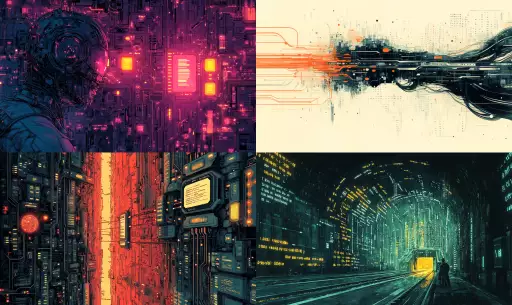Explore the Best AI Image Gallery

Pixels on the Skin: How AI Image Generation is Transforming Design
The creative landscape is undergoing a seismic shift with the emergence of AI image generation. These powerful algorithms can now create stunning visuals, from realistic photographs to abstract art, at an unprecedented speed and scale. This technology is poised to revolutionize the design industry, offering both exciting opportunities and complex challenges.
Unleashing Creative Potential: Applications in Design
AI image generation is already making its mark across various design disciplines:
- Marketing & Advertising: Generate eye-catching visuals for campaigns, social media, and product packaging, tailoring them to specific audiences.
- Branding & Identity Design: Create unique logos, mascots, and visual elements that capture the essence of a brand.
- Web & UI/UX Design: Develop prototypes and mockups rapidly, exploring different design iterations and user interface concepts.
- Fashion & Product Design: Visualize new garment designs, experiment with textures and patterns, and create 3D models for product development.
- Architecture & Interior Design: Generate realistic renderings of buildings, interiors, and urban landscapes to aid visualization and client presentations.
The Human Touch: Collaboration Between AI and Designers
While AI image generation tools are powerful, they are not meant to replace human designers. Instead, they serve as a collaborative partner, amplifying the creative process:
- Streamlining Workflow: AI can handle repetitive tasks, such as generating variations of a design or creating backgrounds, freeing up designers to focus on more conceptual and strategic aspects.
- Exploring New Ideas: AI can generate unexpected concepts and visual combinations, inspiring designers to think outside the box.
- Iterating Quickly: Designers can experiment with multiple iterations of a design in real-time, using AI feedback to refine and improve their creations.
Navigating Ethical Considerations
The rise of AI image generation brings forth important ethical considerations that designers and the industry must address:
- Copyright & Ownership: Questions arise about the ownership of AI-generated images. Who holds the copyright – the developer of the AI, the user who prompts it, or the AI itself?
- Bias & Representation: AI algorithms can inherit biases from the data they are trained on. Its crucial to ensure that AI-generated imagery is diverse and representative, avoiding harmful stereotypes.
- Authenticity & Trust: The increasing ease of creating realistic images raises concerns about authenticity and the potential for misuse, such as deepfakes.
The Future of Design: A Symbiotic Relationship
AI image generation is not a replacement for human creativity but rather a powerful tool that enhances it. As this technology continues to evolve, we can expect:
- More sophisticated AI models:** capable of generating even more realistic and nuanced visuals.
- Greater personalization: AI can tailor designs to individual preferences and needs.
- Seamless integration into design workflows: AI tools will become increasingly intuitive and user-friendly, seamlessly integrated into existing design software.
The future of design lies in a symbiotic relationship between human creativity and AI technology. By embracing this partnership, we can unlock new possibilities for innovation and push the boundaries of what is possible in the creative realm.



![**Representation: A dog acting as a private tutor to a child. The dog holds a ruler in its paw and stands at the blackboard to explain a dog diagram to the child. Graphic style: Line drawing, cartoon style, influenced by Franco-Belgian comics, thick black lines, simplified design, vector, black and white only, in the style of Keith Haring or the French comic strip "Alinéa". [IMPORTANT]: A single continuous line extending from one side of the image to the other, minimalist, strong outlines, line drawing, without lifting the hand, ultra-simplified, no shading, entirely white image, drawing created in the center of a sheet of paper. --ar 16:5** - <@627984126871470085> (fast)](https://images.ai-img.art/thumbnails/150/7a854648a81e51241dcca8d24dd6e3bfcf07ad1df51baf401c9b729f4cf411fa.webp)


](https://images.ai-img.art/thumbnails/150/157712d76865d557120f9baf988de3d0525225295a2789c89bf2c4a5a96a03d1.webp)










![**Representation: A dog acting as a private tutor to a child. The dog holds a ruler in its paw and stands at the blackboard to explain a dog diagram to the child. Graphic style: Line drawing, cartoon style, influenced by Franco-Belgian comics, thick black lines, simplified design, vector, black and white only, in the style of Keith Haring or the French comic strip "Alinéa". [IMPORTANT]: A single continuous line extending from one side of the image to the other, minimalist, strong outlines, line drawing, without lifting the hand, ultra-simplified, no shading, entirely white image, drawing created in the center of a sheet of paper. --ar 16:5** - Variations (Strong) by <@627984126871470085> (fast)](https://images.ai-img.art/thumbnails/150/f4e034998ccd869d8a061fd12017514fcd92210eb33d4222dc9b54716223f4dd.webp)

![**Representation: A teenager smiling while thinking about a friendly dog, a comic-style thought bubble with a friendly dog inside. Graphic style: Line drawing, cartoon style, influenced by Franco-Belgian comics, thick black lines, simplified design, vector, black and white only, in the style of Keith Haring or the French comic strip "Alinéa". [IMPORTANT]: A single continuous line extending from one side of the image to the other, minimalist, strong outlines, line drawing, without lifting the hand, ultra-simplified, no shading, entirely white image, drawing created in the center of a sheet of paper. --ar 16:5** - <@627984126871470085> (fast)](https://images.ai-img.art/thumbnails/150/6fc850f638e3dee0c4b121acecad2c8419e02bdeac7f871d625f1003c1c3abe1.webp)




](https://images.ai-img.art/thumbnails/150/51c93500396faff4e7fa8b42bc68033067b16b2230e3496e95c482a581ff0fe9.webp)















](https://images.ai-img.art/thumbnails/150/9d51c5e673b4f2068b7b01abc35425a06f173b76303adf9ad29ca14302c25b18.webp)



